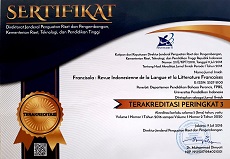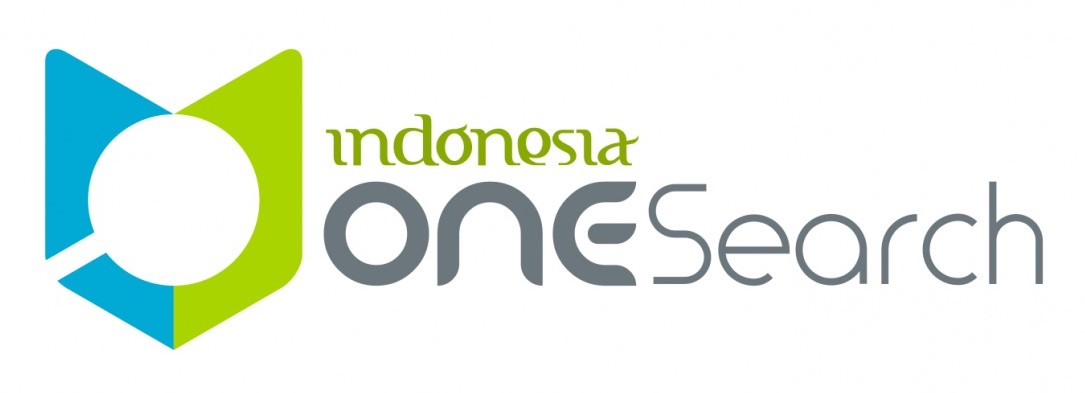Cultural Diplomacy in French Language Teaching manuals
Abstract
RÉSUMÉ. Cet article se concentre sur la manière dont les efforts de diplomatie culturelle française sont menés à travers de l'enseignement des langues et comment la France était le pionnier de la diplomatie culturelle moderne à travers les établissements d'enseignement de la langue. En utilisant l'approche d'analyse critique du discours de Fairclough (dans Haryatmoko, 2016) et la théorie de “Soft Power Currencies” de Vuving (2009), cette étude a trouvé diverses images positives concernant l'État français, la société et ses produits culturels en français, dans des manuels d'enseignement des langues étrangères. Ces images sont construites par des éléments visuels et la sélection de sujets qui deviennent implicitement les outils de la France dans la mise en œuvre de la puissance douce à travers principalement les aspects de «brilliance» et de «beauty» pour le lecteur. Ces aspects révèlent que l'intention de les mettre en œuvre est de produire de l'admiration; tandis que «benignity» se trouve principalement dans la bonté, la gentillesse et la tolérance, un aspect rarement retrouvé dans les méthodes.
Mots-clés : Apprentissage des langues, Diplomatie culturelle, Langue française, Soft Power Currencies
ABSTRACT. This article focuses on how French cultural diplomacy efforts are carried out through language teaching and how France has pioneered modern cultural diplomacy through language learning institutions. Using the Critical Discourse Analysis approach by Fairclough (in Haryatmoko, 2016) and Vuving's Soft Power Currencies theory (2009), this study found various positive images regarding the French state, society and its cultural products in French, in foreign language teaching manuals. These images are constructed by visual elements and the selection of topics which implicitly become France's tools in implementing soft power through mostly the aspects of “brilliance” and “beauty” for the reader. These aspects reveal that the intention to implement them is to produce admiration; while benignity is mostly found in goodness, kindness and tolerance, which is an aspect rarely found in the methods.
Keywords : Cultural Diplomacy, French, Language Learning, Soft Power Currencies
Full Text:
PDFReferences
Alliance Française. (2019). Fonctionnement de la fondation. Alliance Française. Retrieved October 19, 2019, from AF website: https://www.fondation-alliancefr.org/?p=440
Almer, J. I. (2018). Ragam Pandangan Terhadap Konsep Soft Power. Universitas Indonesia. Retrieved from http://lib.ui.ac.id/
Berthet, A., Daill, E., Hugot, C., Kizirian, V. M., & Waendendries, M. (2012). Alter Ego+ A1. Paris: Hachette FLE.
Chatin, M. (2016). Brazil: analysis of a rising soft power. Journal of Political Power, 9(3), 369–393. https://doi.org/10.1080/2158379x.2016.1232286
Council of Europe. (2001). Common European Framework of Reference for Languages: Learning, Teaching, Assessment. Cambridge: Cambridge University Press
Ding, S. (2010). Analyzing Rising Power from the Perspective of Soft Power: a new look at China’s rise to the status quo power. Journal of Contemporary China, 19(64), 255–272. https://doi.org/10.1080/10670560903444207
Fairclough, N. (2009). A dialectical-relational approach to critical discourse analysis in social research. In Wodak, R., & Meyer, M. (2009). Methods for Critical Discourse Analysis (Second ed.) pp. 162-186. SAGE Publications.
Hachette FLE. (2019). Méthodes pour Grands ados et adultes. Retrieved 18 November 2019 from: https://www.hachettefle.com/collections/alter-ego-plus
Haryatmoko. (2016). Critical Discourse Analysis [Analisis Wacana Kritis]: Landasan Teori, Metodologi, dan Penerapan. Rajagrafindo Persada.
Hymans, J. E. (2009). India's soft power and vulnerability. India Review, 8(3), 234-265.
Kaur, K., Arumugam, N., & Yunus, N. M. (2013). Beauty Product Advertisements: A Critical Discourse Analysis. Asian Social Science, 9(3), 61–70. https://doi.org/10.5539/ass.v9n3p61
Kinnunen, M. (2009). Présence et Représentation de La Culture Française dans Les Manuels de La Série Voilà!. Jyväskylä : Université de Jyväskylä, Finland. Retrieved 14 February 2019 from https://jyx.jyu.fi/bitstream/handle/123456789/19731/URN_NBN_fi_jyu-200903171158.pdf?sequence=1
Kiseleva, Yulia. (2015). Russia’s Soft Power Discourse: Identity, Status and the Attraction of Power. In POLITICS: 2015 VOL 35(3-4), 316–329. Retrieved 18 November 2019 from https://www.uscpublicdiplomacy.org/sites/uscpublicdiplomacy.org/files/Kiseleva-2015-Politics.pdf
Lee, G. (2009). A theory of soft power and Korea’s soft power strategy. Korean Journal of Defense Analysis, 21(2), 205–218. https://doi.org/10.1080/10163270902913962
Mark, S. L. (2010). Rethinking cultural diplomacy: The cultural diplomacy of New Zealand, the Canadian Federation and Quebec. In Political Science, 62(1), 62–83. https://doi.org/10.1177/0032318710370466
Pajtinka, E. (2014). Cultural Diplomacy in the Theory and Practice of Contemporary International Relations. In Politické vedy. 17(4) 2014. ISSN 1335 – 2741,s.95-108. Retrieved from https://www.researchgate.net/publication/269763112_Cultural_Diplomacy_in_Theory_and_Practice_of_Contemporary_International_Relations
Prasari, D. A. (2014). Kawaii Culture Sebagai Soft Power Jepang Berdasarkan Soft Power Currencies. Universitas Indonesia. Retrieved 24 February 2019 from http://lib.ui.ac.id/detail?id=20402935
Puren, C. (2010). Les manuels récents de français langue étrangère : entre perspective actionnelle et approche communicative. In FULGOR 4(2), December 2010 ISSN 1446–9219. Retrieved from https://dspace.flinders.edu.au/
Rahayu, S. P., & Armini A. (2010). Mille Chemins Créatifs pour Enseigner Le Français. Yogyakarta: Universitas Negeri Yogyakarta. Retrieved 15 February 2019 from http://staff.uny.ac.id/sites/default/files/Mille%20Chemins%20Cr%C3%A9atifs%20pour%20Enseigner%20Le%20Fran%C3%A7ais2.pdf
Ramanathan, R. (2015). Application of Critical Discourse Analysis in Media Discourse Studies. In 3L: The Southeast Asian Journal of English Language Studies – Vol 21(2): 57 – 68. Retrieved 3 May 2019 from http://ejournals.ukm.my/3l/article/viewFile/9183/3421
Schneider, C. P. (2005). Culture Communicates: US Diplomacy That Works. In Melissen, J. (Ed.) The New Public Diplomacy: Soft Power in International Relations. Basingstoke: Palgrave Macmillan
Tella, O. (2016).Wielding soft power in strategic regions: an analysis of China’s power of attraction in Africa and the Middle East. Africa Review, 8:2, 133-144, DOI: 10.1080/09744053.2016.1186868
Vuving, A. L. (2009). How Soft Power Works. In SSRN Electronic Journal – September 2009. Retrieved 14 February 2019 from https://www.researchgate.net/publication/256003336_How_Soft_Power_Works
Wulansuci, Y. (2010). Budaya populer Manga dan Anime sebagai soft power Jepang. Universitas Indonesia. Retrieved 24 February 2019 from http://lib.ui.ac.id/detail?id=20160972
DOI: https://doi.org/10.17509/francisola.v5i2.32268
Refbacks
- There are currently no refbacks.
Copyright (c) 2021 FRANCISOLA

This work is licensed under a Creative Commons Attribution-ShareAlike 4.0 International License.
View My Stats











